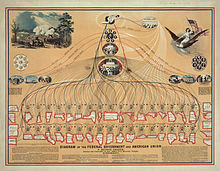This is an old revision of this page, as edited by 195.224.65.38 (talk) at 10:54, 10 October 2019. The present address (URL) is a permanent link to this revision, which may differ significantly from the current revision.
Revision as of 10:54, 10 October 2019 by 195.224.65.38 (talk)(diff) ← Previous revision | Latest revision (diff) | Newer revision → (diff) Social entity established to meet needs or pursue goals "Organised" redirects here. For other uses, see Organization (disambiguation) and Org (disambiguation).| This article includes a list of general references, but it lacks sufficient corresponding inline citations. Please help to improve this article by introducing more precise citations. (October 2014) (Learn how and when to remove this message) |

An organization or organisation is an entity comprising multiple people, such as an institution or an association, that has a particular purpose.
The word is derived from the Greek word organon, which means tool or instrument, musical instrument, and organ.
Types
Structures

sucking my willie
- Affinity group
- Business organization
- Coalition
- Collective
- Decentralized autonomous organization
- List of designated terrorist organizations
- List of environmental organizations
- List of general fraternities
- List of international professional associations
- List of trade unions
- Maturity Model
- Multidimensional organization
- Mutual organization
- Organizational psychology
- Organization Workshop
- Organization's goals
- Pacifist organization
- Requisite organization
- Service club
- Size of groups, organizations, and communities
- Umbrella organization
- Voluntary association
References
- General
- Coase, Ronald (1937). "The Nature of the Firm" Economica, 4(16), pp. 386–405.
- Handy, Charles (1990). Inside Organizations: 21 Ideas for Managers. London: BBC Books. ISBN 978-0-563-20830-3.
- Handy, Charles (2005). Understanding Organizations (4th ed.). London: Penguin Books. ISBN 978-0-14-015603-4.
- Hewlett, Roderic. (2006). The Cognitive leader. Rowman & Littlefield Pub Inc.
- Johnson, Richard Arvid (1976). Management, systems, and society : an introduction. Pacific Palisades, Calif.: Goodyear Pub. Co. ISBN 0-87620-540-6. OCLC 2299496.
- Katz, Daniel; Kahn, Robert Louis (1966). The social psychology of organizations. New York: Wiley. OCLC 255184.
- March, James G.; Simon, Herbert A. (1958). Organizations. New York: Wiley. ISBN 0-471-56793-0. OCLC 1329335.
- Marshak, Thomas (1987). "organization theory," The New Palgrave: A Dictionary of Economics, v. 3, pp. 757–60.
- Mintzberg, Henry (1981). "Organization Design: Fashion or Fit" Harvard Business Review (January February)
- Morgenstern, Julie (1998). Organizing from the Inside Out. Owl Books ISBN 0-8050-5649-1
- Peter, Laurence J. and Raymond Hull. The Peter Principle Pan Books 1970 ISBN 0-330-02519-8
- Rogers, Carl R.; Roethlisberger, Fritz Jules (1990). Barriers and gateways to communication. Boston, Mass.: Harvard Business Review. OCLC 154085959.
- Samson, D., Daft, R. (2005). Management: second Pacific Rim edition. Melbourne, Victoria: Thomson
- Satir, Virginia (1967). Conjoint family therapy; a guide to theory and technique. Palo Alto, Calif: Science and Behavior Books. OCLC 187068.
- Scott, William Richard (2008). Institutions and Organizations (3rd ed.). London: Sage Publications Ltd. ISBN 978-1-4129-5090-9.
External links
- Research on Organizations: Bibliography Database and Maps
- TheTransitioner.org: a site dedicated to collective intelligence and structure of organizations